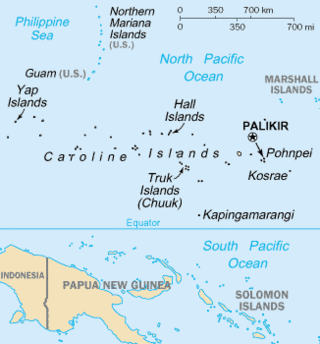
Micronesia is a subregion of Oceania, consisting of about 2,000 small islands in the Northwestern Pacific Ocean. It has a close shared cultural history with three other island regions: Maritime Southeast Asia to the west, Polynesia to the east, and Melanesia to the south—as well as with the wider community of Austronesian peoples.

Pohnpei is an island of the Senyavin Islands which are part of the larger Caroline Islands group. It belongs to Pohnpei State, one of the four states in the Federated States of Micronesia (FSM). Major population centers on Pohnpei include Palikir, the FSM's capital, and Kolonia, the capital of Pohnpei State. Pohnpei Island is the largest with an area of 334 km2 (129 sq mi), and a highest point of 782 m (2,566 ft), the most populous with 36,832 people, and the most developed single island in the FSM.

The Caroline Islands are a widely scattered archipelago of tiny islands in the western Pacific Ocean, to the north of New Guinea. Politically, they are divided between the Federated States of Micronesia (FSM) in the central and eastern parts of the group, and Palau at the extreme western end. Historically, this area was also called Nuevas Filipinas or New Philippines, because they were part of the Spanish East Indies and were governed from Manila in the Philippines.
In addition to its classical and literary form, Malay had various regional dialects established after the rise of the Srivijaya empire in Sumatra, Indonesia. Also, Malay spread through interethnic contact and trade across the Malay Archipelago as far as the Philippines. That contact resulted in a lingua franca that was called Bazaar Malay or low Malay and in Malay Melayu Pasar. It is generally believed that Bazaar Malay was a pidgin, influenced by contact among Malay, Hokkien, Portuguese, and Dutch traders.
The Micronesians or Micronesian peoples are various closely related ethnic groups native to Micronesia, a region of Oceania in the Pacific Ocean. They are a part of the Austronesian ethnolinguistic group, which has an Urheimat in Taiwan.
An English-based creole language is a creole language for which English was the lexifier, meaning that at the time of its formation the vocabulary of English served as the basis for the majority of the creole's lexicon. Most English creoles were formed in British colonies, following the great expansion of British naval military power and trade in the 17th, 18th and 19th centuries. The main categories of English-based creoles are Atlantic and Pacific.

A French creole, or French-based creole language, is a creole for which French is the lexifier. Most often this lexifier is not modern French but rather a 17th- or 18th-century koiné of French from Paris, the French Atlantic harbors, and the nascent French colonies. This article also contains information on French pidgin languages, contact languages that lack native speakers.

The Saudeleur dynasty was the first organized government uniting the people of Pohnpei island, ruling from c. 1100-1200 CE to c. 1628 CE. The era was preceded by the Mwehin Kawa or Mwehin Aramas, and followed by Mwehin Nahnmwarki. The name Deleur was an ancient name for Pohnpei, today a state containing the capital of the Federated States of Micronesia.
The Pingelapese language is a Micronesian language native to Pingelap, an atoll belonging to the state of Pohnpei in the Federated States of Micronesia. This atoll is the homeland to the Pingelapese people, consisting of a three-square mile range of uninhabited small coral islets, Daekae and Sukora, and the inhabited islet, Pingelap. These islands partially make up the Caroline Islands.
Mokilese also known as Mwoakilloan, Mwokilese, or Mwoakilese is a Micronesian language originally spoken on Mwoakilloa, Federated States of Micronesia. Of the 1200 Mokilese speakers, only about 500 live on Mwoakilloa.
The Ngatik massacre took place over two days of fighting on the atoll of Sapwuahfik in the Micronesian island chain in July 1837. Captain C. H. Hart and his crew of beachcombers of the trading cutter Lampton from Sydney, Australia, massacred as many as 50 Sapwuahfik men. Hart had hoped to raid what he believed was a large stash of tortoiseshell on the island.
Japanese settlement in the Marshall Islands was spurred on by Japanese trade in the Pacific region. The first Japanese explorers arrived in the Marshall Islands in the late 19th century, although permanent settlements were not established until the 1920s. As compared to other Micronesian islands in the South Seas Mandate, there were fewer Japanese who settled in the islands. After the Japanese surrender in 1945, the Japanese populace were repatriated to Japan, although people of mixed Japanese–Marshallese heritage remained behind. They form a sizeable minority in the Marshall Islands' populace, and are well represented in the corporate, public and political sectors in the country.

Sapwuahfik, formerly Ngatik, or the Raven Islands is a 110-square-kilometer (42 sq mi) atoll of the Federated States of Micronesia. It is a village and municipality of roughly 430 people on a land area of 1.5 square kilometers (0.58 sq mi) in the state of Pohnpei.
Isokelekel, also called Idzikolkol, was a semi-mythical hero warrior from Kosrae who conquered the Saudeleur Dynasty of Pohnpei, an island in the modern Federated States of Micronesia, sometime between the early 16th century and early 17th century. Some Kosraean variants name this hero Nanparatak, with features closer to Ulithian tales of the same archetype. He is considered the father of modern Pohnpei.

Micronesian Pidgin is an English-based pidgin language spoken in nineteenth-century Micronesia. It may have been related to Melanesian Pidgin English, due to a number of workers from Melanesia.
Ngatikese, or Sapwuahfik, is a Micronesian language originating on Sapwuahfik atoll, Federated States of Micronesia. Of the 700 Ngatikese speakers, only about 450 live on Sapwuahfik. It was previously considered a distinct dialect of Pohnpeian, but was later reclassified as the two proved to be only partially mutually intelligible. It is currently considered vulnerable, as many of its speakers have gradually shifted to Pohnpeian.






